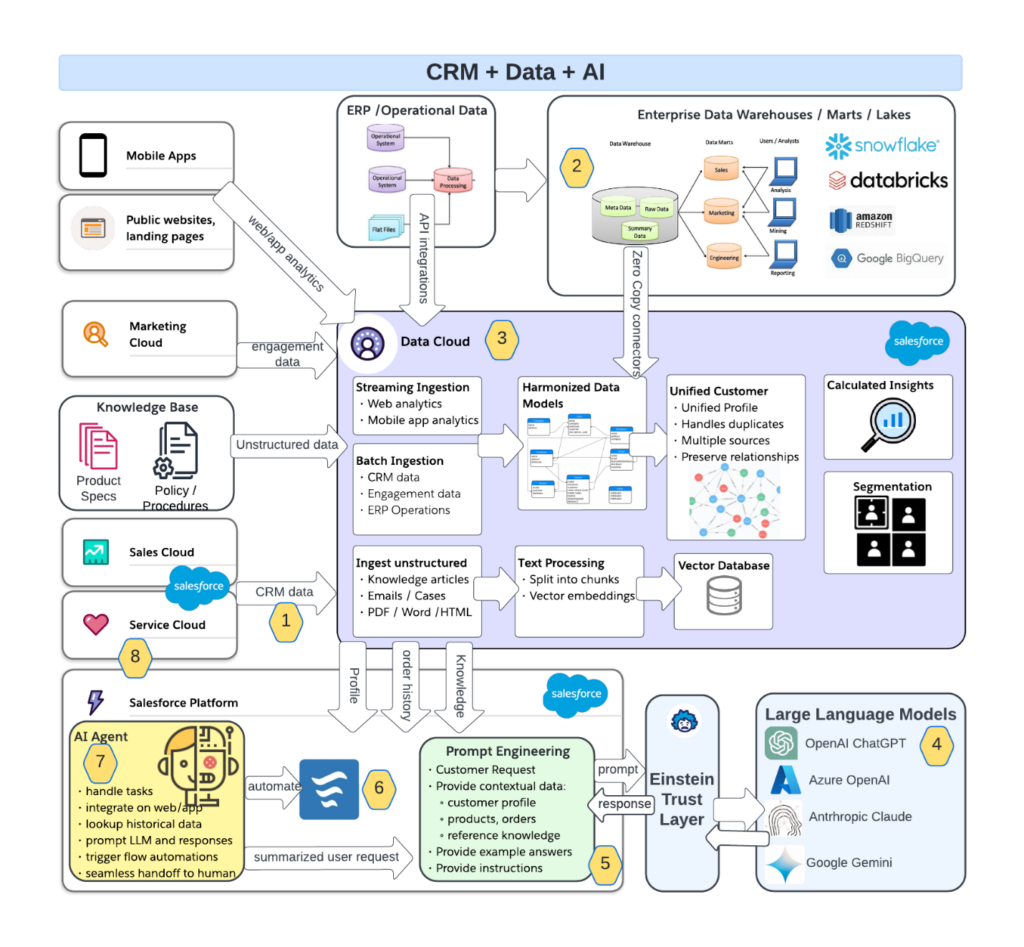From hype to reality: AI's game-changing role in Service and Sales

AI for service and sales is finally at the tipping point for rapid innovation.
Last month, I attended Dreamforce in San Francisco, hosted by Salesforce. As a principal consultant in the Salesforce practice at Turnberry Solutions, I aimed to learn about how Salesforce clients are using CRM, Data Cloud, and AI features. My goal was to figure out how we can best help Turnberry clients get real business value out of their Salesforce investments.
In past years, with the platform and previous Dreamforce announcements, I have been pretty pessimistic about the value of AI and the many “Einstein” branded features. It always felt challenging for an enterprise to gain a significant ROI by implementing these features. These features included scoring leads with a higher propensity to purchase, suggesting the service agent’s “next best action,” providing recommendations for cross-sell and upsell opportunities and offering case resolution suggestions. However, these capabilities require a substantial amount of quality data in the CRM and knowledge base to effectively assist real users and enhance customer outcomes.
In reality, customer data is often unreliable and contains numerous duplicate contacts. Any insights your CRM can generate about a customer or lead are hindered by duplicates, missing information, and the absence of key data sources. And your Salesforce knowledge base is often not great either – if you are even using it! Building self-service capabilities with chatbots was also challenging, particularly when it came to predicting customer questions and creating decision trees and a knowledge base that actually helped customers rather than frustrating them. But after this year’s conference, I was completely blown away by how much has changed. The lightbulb has gone off for me, and I believe we’re at a true tipping point for AI in Customer Service and Sales. Every existing or new Salesforce Customer needs to stand up and pay attention to what Salesforce is capable of doing now. It is time for you to take notice.
Several Salesforce features released in the past year have impressed me:
- Agentforce functionality (formerly Co-Pilot) to build AI Agents that can assist a humans or provide customer self service in a web chat or app.
- Ingestion of unstructured data (PDF, HTML, Word docs) into a vector database with search indexes
- Zero copy data warehouse data can be ingested into Data Cloud
- Prompt Builder to engineer your prompts for an LLM
During Dreamforce, I was fortunate to wander into a workshop where I actually built an AI agent in about 90 minutes that could automatically provide responses for a case (incoming email) from the product sheets or company knowledge. I was blown away at how easy it was to set up. All configuration. No need for a developer or LLM experts. A product manager can do all of this if they have some data orientation. The hardest part in all of this is the mapping of your external data sources to a unified data model in Data Cloud.

I can see this use case being extremely powerful for Service and Sales. This is how a company would put it together:
- CRM: Service/Sales Cloud
- Contact information and demographics
- Summary information about the Account or Household
- History of all service cases
- Full interaction history (calls, meetings, emails, etc.)
- History of sales opportunities
- History of marketing campaign membership
- Categorization and segmentation
- CSAT and Net Promoter Scores
- Data warehouses and data lakes
- Leverage any data from your warehouse!
- Data Cloud can integrate with zero copy support for Amazon Redshift, Databricks, Google Cloud BigQuery, and Snowflake
- Data Cloud
- CDP unifying profile of the customer contact where customer data from your many various databases, warehouse, ERP, and third-party external sources is married together
- Data warehouse data sources
- API integrations bring in order history and product data from ERP, Order Management, or legacy back-office systems
- Near real-time streaming of web/app analytics data
- Calculated insights on the customer based on all of this data
- Segmentation
- Ingest unstructured data (PDFs, Word, HTML), OCR, break into chunks, stored into a vector database with search indexes to enable finding information relating to a topical search. Examples:
- Product sheets and brochuresContract terms and conditionsLegal contractsService agreementsInternal process documentation
- LLM
- Plug in one of the generative AI large language models that are supported
- Also supports “bring your own model,” but this is not likely needed for regular customer service
- Salesforce Trust Layer ensures the LLM responses are sanitized and prevents rogue AI behavior
- Prompt engineering
- Salesforce provides features and framework in order to engineer prompts for LLMs to solve a specific task or problem.
- Call the LLM and provide the following:
- Summarized customer’s questionContext: current products owned, historical purchases made, current CSAT or Net Promoter Scores, and segmentationThe source for where to get answers: results of a topical search from the unstructured dataExamples of the format of good answers
- Platform automation and integrations
- Using Salesforce flows, we can automate many tasks given input data, such as placing an order, canceling a membership, or resetting a password.
- Low or no code – these are easily maintained as the business requirement changes
- Can perform automations triggered by an AI agent or a change in data in the CRM or in the Data Cloud
- Can quickly grab a calculated insight from Data Cloud (e.g. lifetime value, propensity, etc.)
- Can call an API to get a piece of data from an external system
- AI agents
- The AI agent is built as a co-pilot for the human service agent or it can be a self-service chatbot on the website or mobile app
- AI agent is designed to answer specific questions and have it complete certain tasks, such as providing answers to customer questions using knowledge base and product documentation or automating the process of returning and ordering a replacement product
- AI agent can do the following:
- Action an LLM to summarize a customer’s issue or interaction
- Action a search of unstructured data from the Data Cloud
- Chat widget on your website or app
- Also have SMS, WhatsApp, and Facebook Messenger support
- Seamless handoff to your human service and sales agents
- Service center management
- Monitoring your AI agents in real-time just as you would monitor your human agents
- Seamless handoff to a human agent when the AI agent is not trained for a specific action or topic – human agents can see a summary of the interaction and a full transcript

A majority of CEOs of large enterprises have some initiatives to figure out how AI can be leveraged in their companies. Publicly traded companies especially have a desire to be able to answer questions about how they are using AI. Some are exploring using their own LLMs trained on their own data. Others are prompt engineering with the popular LLMs and doing the integrations with their own data warehouses. The problem with a lot of these projects is that your AI capability is siloed and there are huge engineering costs. Handoffs of support and sales to a real human are very clunky.
With Salesforce’s suite of capabilities, Turnberry Solutions can help clients quickly go to market with AI-powered solutions that integrate seamlessly with their CRM and ERP data. By leveraging AI agents to streamline customer interactions, enhance sales opportunities, and provide efficient handoffs to human agents, businesses can significantly improve customer experiences and drive growth. OpenTable, for example, shared at Dreamforce how it built an AI agent for the OpenTable app in just two months with a team of only four people – an effort much more efficient than the company’s previous chatbot projects. Turnberry is ready to help your business achieve similar success with AI-driven innovation.

Resources:
Explore Use Cases for AI : AI Use Cases with Salesforce Einstein | Salesforce US Salesforce Trusted AI Principles: Meet Salesforce’s Trusted AI Principles (salesforceairesearch.com)
Continue reading

Velocity unlocked: how hyperscale teams keep delivery moving
Introduction For most large technology organizations, slowing down is not an option. The pressure to…

Turnberry Solutions welcomes Paul Bertucci as Chief Technology Officer
Turnberry Solutions is excited to welcome Paul Bertucci as our new Chief Technology Officer. Paul joins…

Turnberry Solutions welcomes Mario Ruiz as Head of Strategy and Client Innovation
Turnberry Solutions is pleased to announce that Mario Ruiz has joined the team as Head of…